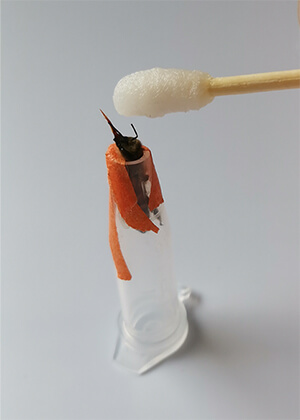Notes from the Lab
How Tropilaelaps mites reduce foraging efficiency of adult honey bees

While the varroa mite is the most important and widespread pest of honey bees across the world, a different mite, Tropilaelaps mercedesae, may be a bigger threat. Tropilaelaps (Photo 1) is smaller than varroa, has a faster reproductive rate, a shorter phoretic phase (i.e., the phase when mite is on adult bees and is most easily controlled), efficiently vectors viruses including Deformed Wing Virus (DWV), and it moves on bees and in colonies like an acrobat. It’s bad news!
Thankfully, Tropilaelaps is still only found in Asia. It made a host switch from the Giant honey bee (Apis dorsata) to the European honey bee (Apis mellifera), which is now commonly kept by beekeepers in some parts of Asia. Because of its very recent host switch onto the European honey bee, the two haven’t coevolved together in nature, which means European honey bees don’t have coevolved defenses against the mite. This same lack of coevolved defenses is true for varroa, which made a host switch from Apis cerana to A. mellifera in the mid-1900s. We all see how that unfortunate dynamic for A. mellifera is playing out right now.
Hopefully Tropilaelaps will stay in Asia and we won’t have to worry about it in North America. But we were also hopeful varroa would stay in Asia until it started spreading throughout the world, eventually showing up in North America in 1987. Hence, it’s probably a good idea for us to start understanding more about Tropilaelaps so we can more effectively grapple with it if (hopefully not when!) it arrives in our backyards.
So, what does Tropilaelaps do to bees? We know it wounds developing larvae/pupae and transmits viruses, sometimes overwhelming a colony with sickness. But what about impacts on foraging adults, who gather all the food for colonies? Does Tropilaelaps impact olfactory learning, flight ability, or homing ability of foragers? And what if we look at gene expression of foragers, can that tell us something about how the bees are stressed? These are the topics for our forty-fifth Notes from the Lab, where we summarize “Tropilaelaps mercedesae parasitism changes behavior and gene expression in honey bee workers,” written by Jing Gao and colleagues and published in the journal PLoS Pathogens [2021].
For their study, Gao and colleagues first needed to create colonies that weren’t infested with Tropilaelaps. To do this, they took advantage of the fact that Tropilaelaps can only survive for two or three days when there are only adult bees around; they caged queens for one month and removed all brood from the experimental colonies. Next, they released the queen and let her start laying, then collected frames of 5th-instar larvae. For treatment bees, one foundress of Tropilaelaps was introduced into a newly sealed brood cell with a 5th-instar larva. Control bees were obtained from brood cells that weren’t infested with Tropilaelaps. A total of 10 brood combs (five infested combs and five controls) were placed in an incubator and newly emerged adults (Tropilaelaps treatment or control) were placed in cages with 30 bees as a group. The adult bees were supplied with syrup and fresh pollen, and the cages were maintained in an incubator.
To measure flight ability, infested and non-infested worker bees were tested 15 days post-emergence on a modified flight mill, which is essentially a small treadmill for bees (Photo 2). Sensors recorded mean velocity, flight duration, and flight distance for ~120 control vs. treatment bees.
To measure homing ability, 300 infested and non-infested bees were randomly collected from brood combs, marked with different colors painted on the thorax, and placed into three non-infested colonies. After three days, all bees were released from approximately 50 m away, and homing time and number of bees successfully returning to the hive were recorded.
To measure responsiveness to sucrose and olfactory learning, bees were assessed for their proboscis extension reflex (PER) by securing them individually in 1.5 mL tubes with their antennae and mouthparts free (Photo 3). Infested vs. non-infested bees were tested for their response to 30% sucrose solutions at 1, 5, 10 and 15 days after emergence. Bees that responded after 15 days were further tested for olfactory learning. For this test, a common floral scent (linalool) was provided at the same time as the sucrose and bees were offered the scent and sucrose several times. Then, only linalool was provided and the infested vs. non-infested bees were monitored to see if they had learned to associate the scent with a reward by extending their proboscis.
Finally, to understand what might be underlying the different behaviors of infested vs. non-infested bees, the heads of bees that ….


